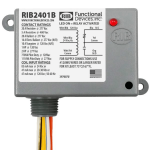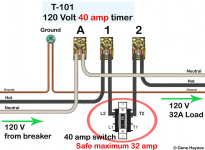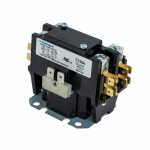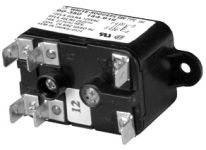I've purchased the pool heater and found all the not included components except the pool contactor. I'm curious what pool contactor to buy. I've been searching for all over and tech support at HotSpot said a Normally Open 24VAC primary with 120v 20 amp secondary. Do you have a picture or remember which contactor you used? Also how do you go about wiring this contactor in parallel to the pump timer?
This depends a lot on your setup. It helps to understand the startup sequence and the purpose of the contactor.
The FPH controller is powered by the AC unit, so the controller always comes on when the AC comes on. The first thing it does is check the temperature of the pool water to see if the pool needs heat. If so, then it redirects the flow of hot gas into the heat exchanger to heat the pool. If not then it does nothing, leaving your AC running normally.
But what if you have your pool pump on a timer, and there's no flow through the FPH plumbing when the AC comes on, because the pump happens to be off at the time? Then the FPH will get a false temperature reading. Or worse, it will try and heat the stagnant water. The FPH needs the pool pump to be running in order to do its job.
So the contactor circuit is meant to give the FPH the ability to turn the pump on whenever it wants. There are a lot of possible ways to make this work, but here are the two most common:
1. You have a single-speed pump with no automation. It's on a timer and turns on/off at certain times of day. You can use a contactor in parallel with your timer to deliver power to the pump whether the timer is on or off.
2. You have a variable-speed pump or an automation system that can use inputs as triggers. Supported options might include continuity inputs (switches) or resistance inputs (temperature sensors). In this case you don't want a high-voltage contactor; you want a relay to give a signal to your pump or controller so that it turns itself on.
In my case, the FPH needed a higher pump speed than I would usually use, so I used a relay-controlled resistor connected to an input meant for a solar temperature sensor. My automation system would put the pump on high when it got the right reading on this input. There are more details in the first post in this thread.
After the FPH does its initial check, it will keep heating the pool as long as the AC is running and the water is below temperature. Optionally, if the AC is running for a long time but the water was already warm enough, you can also set the FPH to recheck the water periodically in case the temperature has gone down. For all of these reasons, you need a contactor or relay that is rated for long cycles. Many inexpensive relays are only meant to be used for short periods of time and will burn out if you leave them activated for too long.
If you still have questions, please share some more details about your pump (single/variable speed, what HP) and how it's currently controlled...





